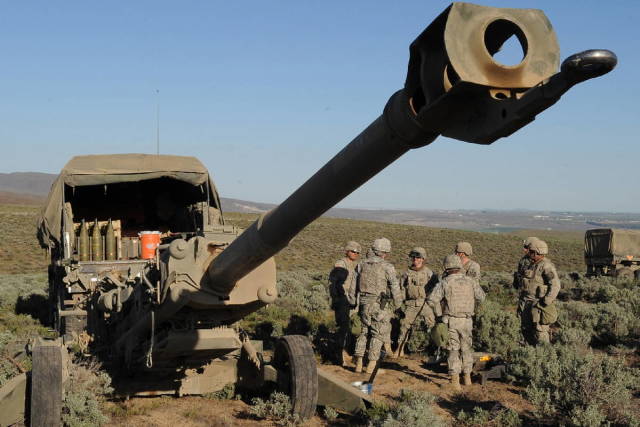On the modern battlefield, towed artillery requires high tactical mobility and the ability to evade enemy attacks. Are there any prospects for this category of artillery systems? Peter Donaldson, a freelance military journalist, is looking for an answer to this question in his publication.
Mobility is both a strength and a weakness of towed artillery, depending on the mobility in question. While the guns, their calculations and ammunition for them represent an almost minimalist weapon system, which in the required amount is easily carried by strategic vehicles (ships, trains, trucks and large transport aircraft), it is much more limited in its tactical mobility.
Avoiding counter-battery fire
For local movement on the battlefield, towed artillery uses wheeled or tracked vehicles, or rotorcraft for air transportation on an external suspension. Helicopters capable of carrying large artillery pieces, ammunition and other equipment tend to be scarce assets, so it is unrealistic to expect them to be constantly at the ready at any moment.
While special towing vehicles or ammunition supply vehicles may remain nearby if they have to move around with guns everywhere, they put additional strain on vehicles that provide them with strategic mobility.
Once in the selected firing position, a typical towed gun must be prepared for firing. This is a complex procedure that may include disconnecting it from the vehicle, digging into the firing site with shovels to give the gun a stable position, topographic mapping and entering the coordinates of the target into a computer that determines the azimuth and elevation angle settings, as well as selects the projectile and charge corresponding to the characteristics of the target, range and temperature.
The first few steps of this process must be performed in reverse order before the gun can be moved to a new firing position or at least away from its current location, which may be crucial for its survival.
Counter-battery fire has been a part of artillery combat for centuries. However, the development of anti-battery radar systems capable of tracking projectiles to their source, and more recently, UAVs, has led to the need to adopt real shoot-and-run tactics.
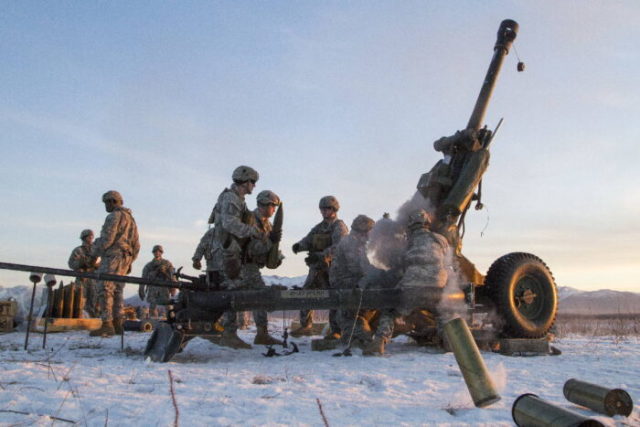
American paratroopers are firing from a 105 mm M119 light gun during an exercise. Light towed guns are much more mobile and easier to maintain than heavier systems.
Naturally, in such circumstances, the emphasis was placed on self-propelled guns integrated with tracked and wheeled vehicles. But the needs of towed artillery have not been forgotten, and several countries have developed auxiliary devices for movement.
Such auxiliary power plants (APUs) usually consist of a diesel power unit mounted on the gun frame. It allows the gun to be moved at moderate speeds, as a rule, independently of its towing vehicle for short distances, which are considered sufficient for independent movement after firing.
Towed artillery in Afghanistan
The wars of the 21st century have simultaneously shifted the West's focus to various types of artillery operations and, for the most part, eliminated the threat of powerful and effective counter-battery fire from enemy artillery. Afghanistan has once again brought the fighting in the mountains to the fore, making light towed guns a more attractive option than large, heavy self-propelled artillery installations. However, steep slopes and turns can make it difficult or impossible to deploy them.
So, during the first major U.S. ground operation in Afghanistan, Operation Anaconda in March 2002, General Tommy Franks decided not to use artillery due to the lack of helicopters capable of deploying guns at high altitudes.
This decision left the 120 mm mortar as the most combat-ready artillery system available to the US Armed Forces. At the same time, it was significantly inferior to the Soviet-made 122-mm towed D-30 howitzers used by the Taliban and Al-Qaeda [organizations banned in the Russian Federation – IVi].
While the apparent artillery gap was successfully filled by tactical aircraft during Operation Anaconda, the experience led some military analysts to call for the return to service of an older artillery piece, namely the 75 mm knapsack howitzer. This compact 680-kilogram gun is much lighter and more convenient to transport than the 7,300-kilogram M198 howitzer and the later 4,200-kilogram M777 155 mm howitzers and even the 2,300-kilogram 105 mm M119 (the American version of the British L118 light gun).
Although the knapsack 75mm howitzer was not re-adopted, the fact that it was considered indicates that the current combination of weapons is far from ideal for all theaters of war and circumstances.
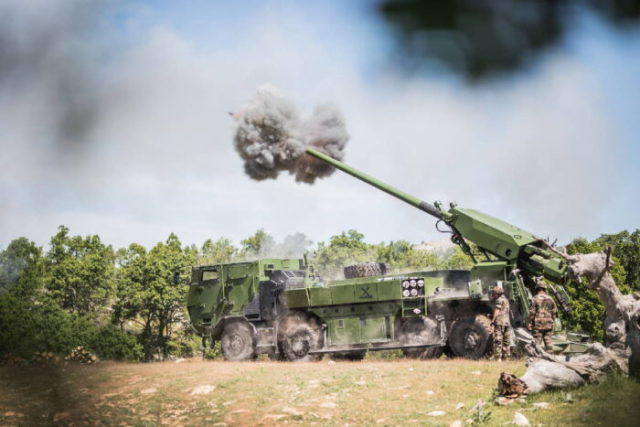
Nexter's 155 mm Caesar 52 caliber cannon mounted on the truck is a type of system that can replace many heavy towed artillery systems.
An almost equal opponent
Renewed attention to the potential confrontation between almost equal opponents has once again highlighted the importance of "shoot and run" tactics, especially in connection with the achievements of the last three decades in the field of high-precision long-range ammunition, UAVs and barrage ammunition.
Although tactical mobility remains critically important, this does not mean that off-road mobility is just as important, said Olivier Fort, marketing director at Nexter. He explained that the latter is still necessary, but not to the same extent as for IFVs and main battle tanks, which are often threatened by direct fire guns. He stressed that from the point of view of mobility for long-range artillery (155—mm systems with a barrel length of 52 calibers), the most important thing is a guaranteed fuel supply.
According to O. Fort, modern artillery systems in service with potential opponents are increasingly capable of disrupting logistical flows far behind the lines of friendly forces. They can use powerful guided munitions to hit point targets and attack columns with submunitions or sensor fuze projectiles. Therefore, artillery protection is becoming increasingly focused on mobility, which is less dependent on an uninterrupted supply chain of high-consumption fuel.
Truck competitions
This is where heavy artillery systems mounted on trucks come to the rescue, such as Caesar from Nexter, Archer from BAE Systems, NORA B-52 from Belgrade Technical Institute of Serbia, ATMOS from Elbit, Norinco SH-15 and Type 19 from Japanese manufacturers.
O. Fort argues that in countries for which the most likely threat is associated with high-intensity combat operations, towed artillery should be replaced by mobile platforms, especially 155-mm guns. "All towed 155 mm platforms take more than two minutes to set them in motion and leave the old position, which is too slow to survive on a modern battlefield. This makes them unsuitable for counter-battery tasks if they are not ready to get away from the shelling, which increases their vulnerability."
Nevertheless, lighter towed platforms remain relevant, he stressed, because of their relative maneuverability, referring to the 30-second deployment/roll-up time of the 105 mm LG light towed howitzer from Nexter.
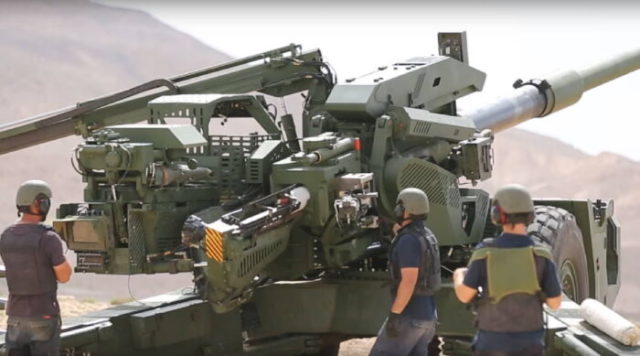
Elbit's 155 mm towed ATHOS cannon is equipped with an engine providing limited independent mobility, combined with automated aiming and loading to enhance tactical maneuverability.
O. Fort also noted that light towed platforms can be hidden behind protected firing positions or airlifted and they are cheaper than self-propelled artillery. This makes them attractive if massive fire is needed and there are no modern counter-battery threats. "Therefore, towed platforms and especially 105mm howitzers and 120mm mortars will not be replaced in the near future."
Limited self-propelled
The renewed focus on rapid tactical mobility also makes heavy towed guns attractive again, which can move independently, provided that their deployment/folding time can be minimized. As pointed out by Fr.However, this feature is often used to help place a gun in a protected firing position or move it to an area inaccessible to a tow truck. This takes a long time and may require rethinking.
One modern example is the autonomous towed artillery system (ATHOS) from Elbit Systems Land. The 155-mm ATHOS howitzer with a 52-caliber barrel is mounted on a carriage, in front of which there is a diesel APU. With the help of hydraulics, it drives the wheels and provides hydraulic and electrical energy to other gun systems.
The automatically controlled system with manual duplication includes GPS navigation, inertial guidance of the gun under the control of an on-board computer and an automatic loading system including a loading tray, a sending mechanism and a crane with a shell holder on which three projectiles are placed at once.
The loading system allows the gun to fire three shots in 30 seconds in the "queue" mode with an "intense" rate of fire of 12 shots in three minutes. A high rate of fire is important for efficiency in avoiding counterbattery fire, and Elbit indicates a maximum sustained rate of fire of 42 rounds per hour (an average of 1.42 rounds per minute).
The company stated that a team of seven people can deploy the system in a firing position "within a few minutes", and indicated a minimum firing range of 5 km, more than 30 km with standard high–explosive fragmentation ammunition and more than 40 km with extended-range projectiles. ATHOS is reported to weigh less than 15 tons.
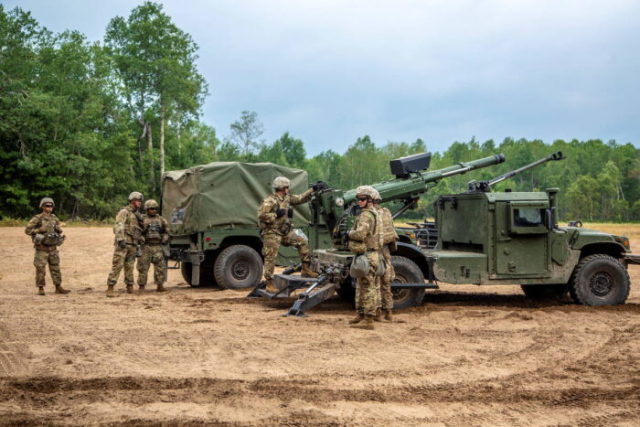
The Mandus Hawkeye howitzer is an idea that provides greater tactical mobility for light guns, but this concept has not been as widespread as heavy guns mounted on trucks.
This system is offered internationally. By announcing an initial order for 400 units. (plus another 1,180 units of local production with technology transfer), India is still deciding for itself whether to continue this purchase or switch to its own improved towed artillery system.
Conceptually similar to the ATHOS 155 mm lightweight towed Pegasus howitzer with a barrel length of 39 calibers from ST Engineering is much lighter at 5.4 tons. The weight is reduced, in part, due to the use of alloys such as aluminum and titanium in its design, as well as controlled recoil, which makes it both self-propelled and easily airlifted (the system is suitable for transportation by C-130 Hercules aircraft or CH-47D/SD Chinook helicopter).
The APU of the gun is based on the Lombardini 9LD625-2 diesel engine with a capacity of 21 kW [about 29 hp – Ivi], which allows the howitzer to move over short distances at speeds up to 12 km/h. Towing of the Pegasus is also possible with vehicles weighing up to 5 tons. In this case, the speed over rough terrain will be up to 50 km/h, and on paved roads – up to 70 km/ h. A crew of 8 people will be able to deploy the gun in a firing position in less than two and a half minutes.
However, in order to achieve mobility and convenience, the Pegasus, compared to the ATHOS, mainly due to the much shorter barrel, sacrifices the firing range. It can hit targets at a distance of 19 km with conventional projectiles and up to 30 km with extended-range ammunition. The rate of fire is also comparable: Pegasus offers "bursts" of three shots in 24 seconds, four shots per minute for three minutes and two shots per minute for 30 minutes. This constant rate of fire is higher than that of ATHOS, but for a shorter period of time.
Used by the Singapore Armed Forces, the towed Pegasus artillery system was purchased to replace 105 mm light guns in artillery units. The service decided to standardize the 155-mm arsenal systems, which also includes the heavier Primus tracked self-propelled guns and FH-88/FH-2000 field howitzers.
The number of such systems on the market is small compared to 155 mm howitzers mounted on trucks, as noted above. In this regard, the U.S. Army is considering the possibility of replacing 155-mm towed artillery systems in its brigade combat groups "Stryker" (Stryker) with a truck-mounted platform.
The easier it is, the better
However, in the lighter part of artillery weapons, light 105-mm towed guns are likely to retain their positions, since they have a number of advantages over alternative options such as missiles and mortars, says O. Fort. "They can be fired along a flat trajectory, which, depending on the terrain, can make them invisible to counter-battery radars."
The lower cost and lower logistical burden associated with ammunition also play in favor of a light gun. Since 105mm shells are much cheaper than missiles, which can be important in mass shooting, and they are also much smaller - many of them can be transported on any logistics vehicle.
As with their heavier counterparts, the idea of mounting light guns on vehicles such as the HMMWV has been explored with weapons such as the 105mm Hawkeye howitzer from the American Mandus Group, which provides them with much greater tactical mobility. While such solutions are likely to find their place in rapid reaction forces, the basic characteristics of light towed artillery in terms of low cost, light weight, compactness and simplicity mean that they are likely to remain, even if the future of heavy towed guns looks more precarious.
Based on the materials of the resource shephardmedia.com
The materials of the article contain exclusively the author's estimates and do not reflect the position of the editorial board of IVi
